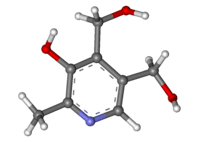Pyridoxine
 | |
 | |
| Names | |
|---|---|
| IUPAC name
4,5-Bis(hydroxymethyl)-2-methylpyridin-3-ol | |
| Identifiers | |
| 65-23-6 58-56-0 (HCl) | |
| 3D model (Jmol) | Interactive image |
| ChEBI | CHEBI:16709 |
| ChEMBL | ChEMBL1364 |
| ChemSpider | 1025 |
| DrugBank | DB00165 |
| ECHA InfoCard | 100.000.548 |
| KEGG | D08454 |
| UNII | KV2JZ1BI6Z |
| |
| |
| Properties | |
| C8H11NO3 | |
| Molar mass | 169.18 g·mol−1 |
| Melting point | 159 to 162 °C (318 to 324 °F; 432 to 435 K) |
| Pharmacology | |
| A11HA02 (WHO) | |
| Except where otherwise noted, data are given for materials in their standard state (at 25 °C [77 °F], 100 kPa). | |
| | |
| Infobox references | |
Pyridoxine (also called pyridoxol,[2] not to be confused with pyridoxal) is one form of vitamin B6. Its hydrochloride salt, pyridoxine hydrochloride, is used as a vitamin B6 dietary supplement.
References
- ↑ Pyridoxine at Sigma-Aldrich
- ↑ p. 11, B Vitamins and Folate: Chemistry, Analysis, Function and Effects, Victor R. Preedy, ed., Royal Society of Chemistry, 2012, ISBN 978-1-84973-369-4; series Food and nutritional components in focus, #4.
External links
This article is issued from Wikipedia - version of the 10/6/2016. The text is available under the Creative Commons Attribution/Share Alike but additional terms may apply for the media files.